#Two Venetian Women
Text

the ineffable wives are done!!! had so so much fun doing this, it turned out beautiful!!
based on the painting Two Venetian Women by Eugene de Blaas!
extra beneath cut!


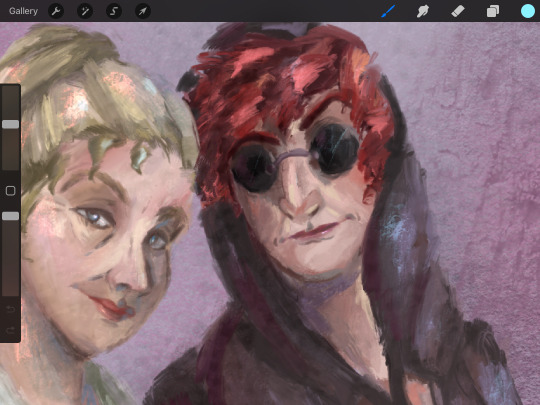
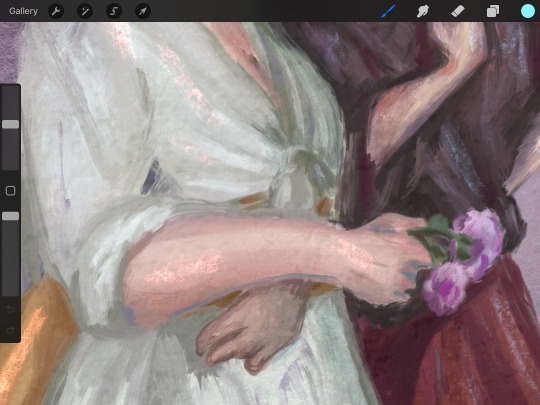
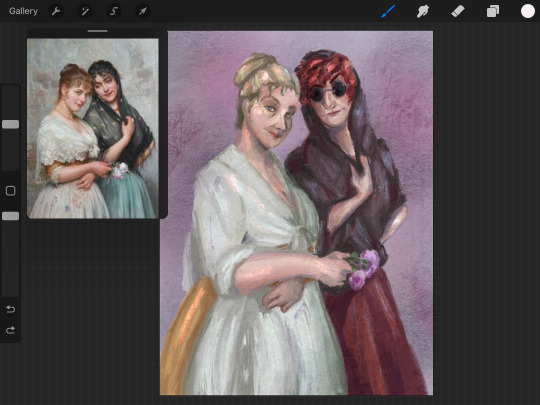
slight trigger warning for flashing images for the speeddraw!
gently tagging @ineffabildaddy
#art by me#fanart#painting#digital#portrait#good omens#good omens 2#good omens 3#ineffable wives#aziraphale x crowley#aziraphale#crowley#fem aziraphale#fem crowley#imitation painting#two venetian women#i needed to hop on the ineffable wives train#there’s just something about fem aziraphale and crowley
33 notes
·
View notes
Text

Two Venetian Women (1898, oil on canvas) | Eugene de Blaas
#art#painting#fine art#oil painting#19th century#two venetian women#eugene de blaas#women#aesthetic#light
6 notes
·
View notes
Photo
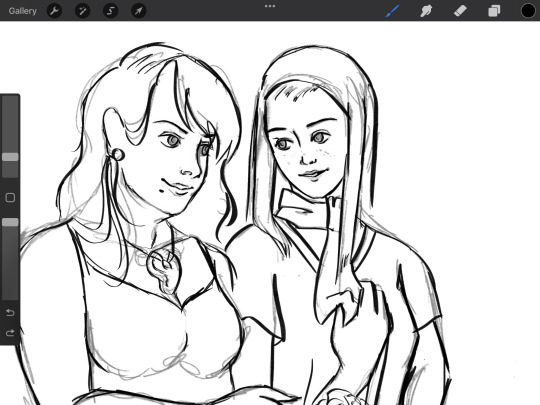
hee hee hoo hoo tha lanamia 4 tonight
#based off two venetian women by de blaas#im proud af of this lana especially#not serious probs not gonna post this but i'm happy with it :')#my art#.txt
17 notes
·
View notes
Text
i learned what is the most bizarre government in world history?
A bit strange that no one speaks of Italian city-states here.
I think they tried just every conceivable form of government. I will tell a bit about my dearest Florentine Republic.
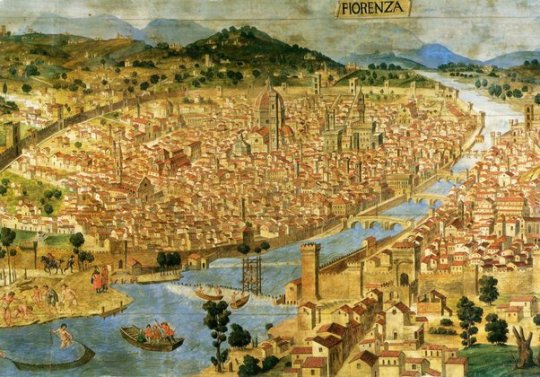
In 13th century, Italian city-states witnessed an intense fight between pro-Emperor and pro-Pope factions. Most nobles were pro-Emperor. Florence was one of the places where they lost the battle, which led to the establishment of democracy.
Of course, this democracy was very different from what we call democracy today. Modern Western countries are representative democracies where people only vote in the elections and countries are governed by professional politicians. A medieval Italian would call such system aristocratic.
Of course, Florentine democracy was also exclusive. Wage labourers, people in debt and women were excluded. But all others could directly participate in government of their country: 5,000–8,000 people out of 25,000–50,000 adult citizens.
Political parties were forbidden (actually, the word party was invented as a slur, something that people do not remember now). Elections were seen as aristocratic mechanism because the rich and the educated would be capable to convince or bribe others to vote for them. So the main mechanism of democracy was casting lots.
Florence was subdivided into four quarters, sixteen neighborhoods and twenty-one corporations (seven major ones representing rich citizens and fourteen minor ones representing poor citizens): every citizen was a member of one of those. Initially, corporations had something to do with profession. Nobles renounced their nobility and joined corporations to be able to participate in the government. For instance, nobleman Dante Alighieri entered the corporation of Doctors and Apothecaries, and the ancestors of Niccolo Machiavelli registered in the corporation of Winemakers.
The main government body was Signoria. It consisted of eight Priors (two representing every quarter, six representing major corporations and two representing minor corporations) and one Gonfalonier of Justice, the chairman. They ruled the city during the period of two months only and then replaced by others. Signoria was the main legislative and executive authority. However, it could take major decisions only in common with other bodies such as Twelve Good Men (three persons from every quarter, mostly rich people) and Sixteen Gonfaloniers (one from every neighbourhood). These three bodies (Signoria, Twelve Good Men and Sixteen Gonfaloniers) were all chosen by lot: notes with their names were chosen from special leather bags preserved in the sacristy of the Santa Croce cathedral.
The laws were approved by the Council of the Commune (192 people, 48 from every quarter, majority rich) and the Council of the People (160 people, 10 from every neighbourhood, majority poor).
There was an enormous quantity of other governing bodies that regulated everything that needed to be regulated in the Republic, from quality checks of the bread to the licensing of the sex workers. In most cases, people served from three to six months. It meant that every full-fledged male citizen of the Florentine Republic could hope to be chosen for one of these positions.
The judicial and military power belonged to the podestà, a foreign citizen with good reputation, legal education and a military company or at least a group of armed servants. Florentines believed that a foreigner would be a more impartial judge in Florentine discussions. A podestà was invited to Florence for six months.
Finally, the Medici family managed to circumvent the system and become rulers of Florence but it took time. The system of checks and balances did work.
However, no one was able to circumvent the government system of Venetian Republic. Do you know why?
For more than five centuries (from 1268 to 1797) the procedure to elect the doge (chief of state) did not change.
Choose 30 members of the Great Council by lot.
These 30 people are reduced by lot to 9.
These 9 people choose 40 other people.
These 40 are reduced by lot to 12.
These 12 people choose 25 other people.
These 25 people are reduced by lot to 9.
These 9 people choose 45 other people.
These 45 people are reduced by lot to 11.
These 11 people choose 41 other people.
These 41 people elect the doge.
Funny that many Americans blame their electoral system for being complicated. You may think what you want about the Venetian system but it guaranteed what was probably the most stable government in the history of mankind.
By the way, despite the fact he was elected for life, the power of the chief of state in Venice was very much limited.
He could not appear in public without other officials present (security from populism). He could not meet foreign diplomats or open foreign dispatches without other officials present (security from collusion with foreign governments). He could not possess any property in a foreign land.
However, he had a nice place to live.

832 notes
·
View notes
Note
Hi :3
Regarding your post on transmasculine cross dressing and prostitution, do you have anymore sources on specifically the Italian instances?
Also I'd love to hear more of your thoughts on it, both in general or in any specific part :3
Here's the source the paper cites (Venice: A Documentary History 1450-1630):
Sexual dissimulation condemned, 1480
From the Latin. Decree of the Council of Ten, 15 March 1480
The coiffure [habitus capitis] which Venetian women have recently taken to wearing could not be more indecent in the sight of God and men, since by means of this coiffure women conceal their sex and strive to please men by pretending to be men, which is a form of sodomy; and therefore be it determined that by the authority of this Council the Heads of the Ten or at least two of them shall go to our Lord Patriarch and persuade him, by means of the confessors and also through an edict to be published in all the parishes, to prohibit the hairstyle [gestamen capillorum] which women adopt, and which they call a 'mushroom' [fungus], and which hides the forehead; and to order the hair to be drawn and tied back behind the head, and the forehead and face to be made free of it, that they may be seen as women, just as God made them, and as was their custom before the presented corrupted age: all of this upon pain of excommunication.
Also the art of a cross-dressing sex worker used in the paper:

Unfortunately, but not surprisingly, I haven't been able to find anything else discussing this.
Its honestly wild to me that in all the discussions of transness and sex work, even specifically historical sex work, I haven't heard anything about this. People seem so uncurious about transmasc history? Its the same thing with the pilipili of Inanna. Like, I've heard so much about the gala as the transfem priestesses of Inanna, but I can barely find anything on the pilipili.
I just wish people would be more self-critical about the absence of both information on transmasculinity, and the lack of interest in analyzing things from that perspective. Stop viewing transmasc absence as natural! People need to start feeling the hole where transmasc stories should be in our cultural and realize how purposeful this exclusion is.
197 notes
·
View notes
Text
IT'S TIME YOU ALL HEARD ABOUT MY GIRL ARCANGELA TARABOTTI, SALTIEST NUN IN CHRISTENDOM

So, I first heard about Arcangela Tarabotti while I was doing the study for my novella THE CITY BEYOND THE GLASS, which is set in Renaissance Venice and inspired by a real historical practice: At one point during the sixteenth century, nearly sixty percent of all the noble women in Venice lived in convents. And the vast majority of them were there against their will.
For complex dynastic reasons (or basically…money and prestige), only one son and one daughter in each generation of Venetian noble families were permitted to marry during this period. The remaining sons resorted to the famous Venetian courtesans to find the companionship which was denied them in marriage, while the spare daughters were locked into convents. The system was unsustainably wasteful and had to be abandoned within a few generations, but by that time it was already too late - many of the old patrician families of Venice were already going extinct. (You can read more on this in Jutta Gisela Sperling’s book Convents and the Body Politic in Late Renaissance Venice).
While it lasted, the system had plenty of opponents. In 1619, Patriarch Giovanni Tiepolo said, "More than two thousand patrician women…live in this city locked up in convents as if in a public tomb. …They are noblewomen, raised and nurtured with the highest delicacy and respect so that if they were of the other sex, they would command and govern the world."
Even when they have suffered oppression, women throughout history have challenged the status quo, and the women of Venice were no different. Arcangela Tarabotti is the foremost example.
Arcangela was just 11 years old when her father sent her to the convent of Sant'Anna. He considered her to be unmarriageable because she had a physical disability, which she had in fact inherited from him. She would spend the rest of her life there, taking vows as a nun in 1623…a fact about which she was in a white-hot fury.
"Why, then, do you defy the works of the Most Just One by decreeing that many women should live all together, alike in dress, dwelling place, food, and conduct, when the Lord of Lords makes it a miracle of His infinite wisdom for all things He created to be different? Why do you want to bend to your whim contrasting wills created so by nature? It is nothing less than wanting to change and correct the deeds of a Creator who cannot err."
During her early years in the cloister, Arcangela gained a reputation for rebellion and outspokenness. At one stage, it took a direct command from the Patriarch himself to force her to cut her hair. Despite this, Arcangela was able to access a high standard of education at the convent and became a philosopher and writer, corresponding with an impressive network of the thinkers of her day. She wrote multiple works critiquing the misogyny entrenched in Venetian society - including a scorching expose titled Paternal Tyranny.
“Only hell itself bears a likeness to the suffering of these enforced slaves of Christ," Arcangela wrote concerning the Venetian women imprisoned in nunneries. "Over the gate of Hell, Dante says, are inscribed the words ‘Abandon every hope, who enter here.’ The same could be inscribed over the portals of convents.”
Contrary to the polemicists of her day, Arcangela maintained that women were fully equal to men and even argued that they should be able to become lawyers and judges. "Both male and female were born free, bearing with them, like a precious gift from God, the priceless bounty of free choice. If in God’s eyes woman is not less privileged than you with respect to her physical or spiritual qualities, why do you wish her to seem created with such great inequality, you enemies of the truth, proclaiming her to be subject to your impulsive, mad whims? In short, woman is deserving of less respect than you only when you have reduced her to this state by your scheming."
"When women are seen with pen in hand, they are met immediately with shrieks commanding a return to that life of pain which their writing had interrupted, a life devoted to the women's work of needle and distaff," she argued.
Tarabotti maintained that she did not condemn all men simply for being men: "Stricken by a guilty conscience, some men will say that I speak with excessive temerity about all men in general. They are greatly mistaken. If they behave justly, they will be protected from my attacks and those of others. I separate the just from the wicked (who are the subject of my discourse), since not all men are bad and not all women are good."
As a keen amateur historian, I’m accustomed to wincing when people assume that all women living before about 1920 were ignorant, oppressed, and unable to inherit or control property (as if world history was not long and diverse and filled with creative, bold, and influential women). For a limited time during the Renaissance, however, things really were incredibly bad for Venetian women. To find out more about Arcangela and her times, I highly recommend Letizia Panizza's translation of PATERNAL TYRANNY, published in 2004 by the University of Chicago Press!
#history#renaissance history#venice#venetian history#women's history#renaissance women#historical fiction#renaissance#17th century#1600s#medieval women#women in history#feminism
313 notes
·
View notes
Text
Powerful women from the classical world + excerpt of a letter from Lord Byron to Thomas Moore describing his lover Margarita Cogni (Venice, September 19th, 1818):

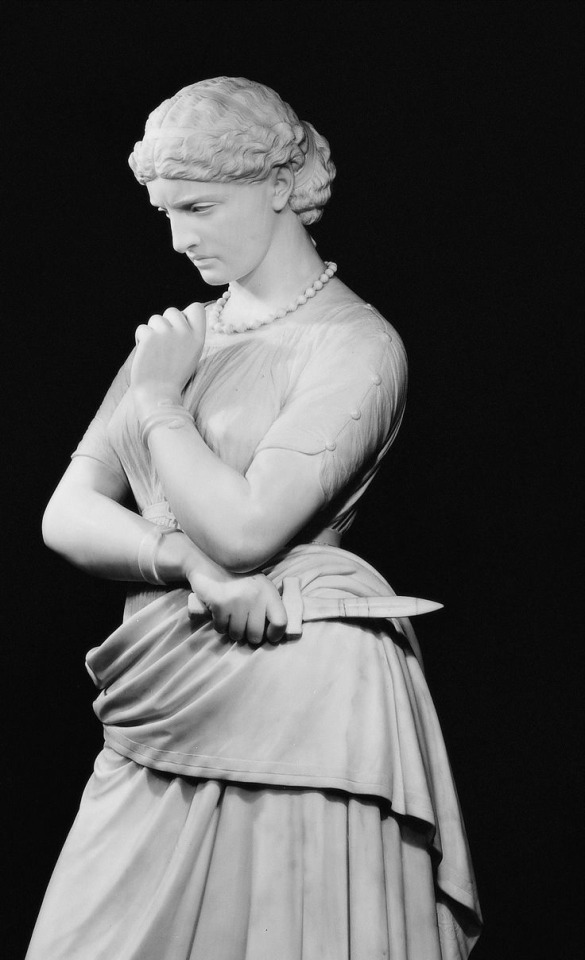
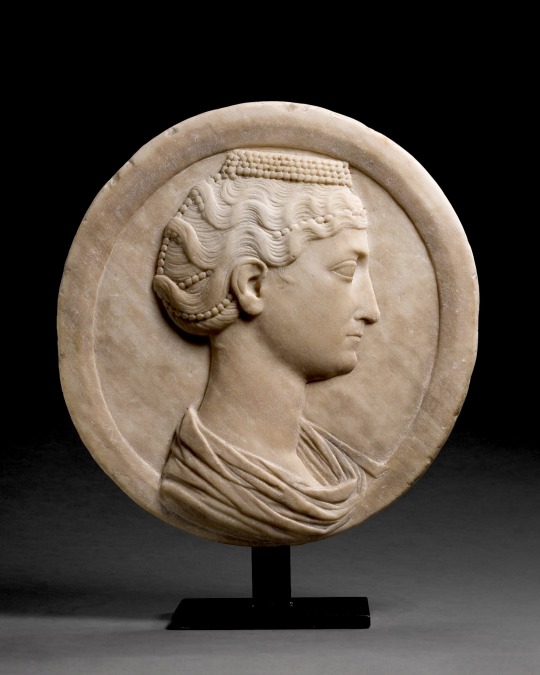
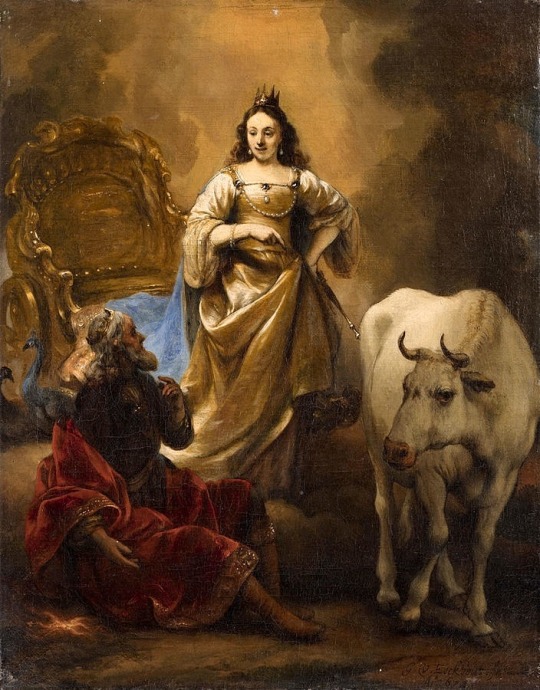
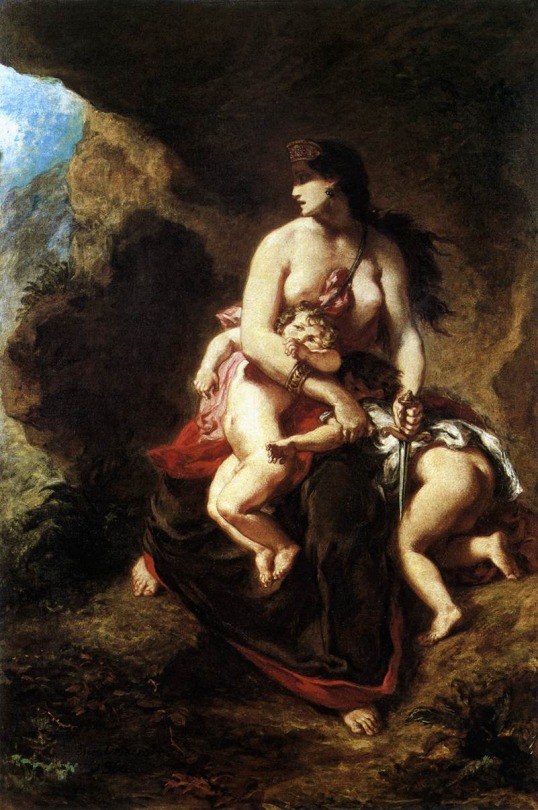
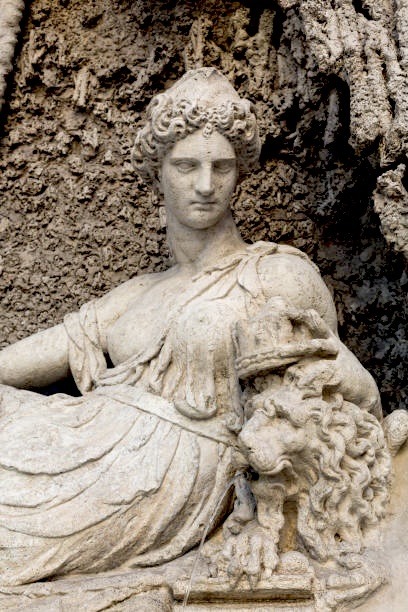
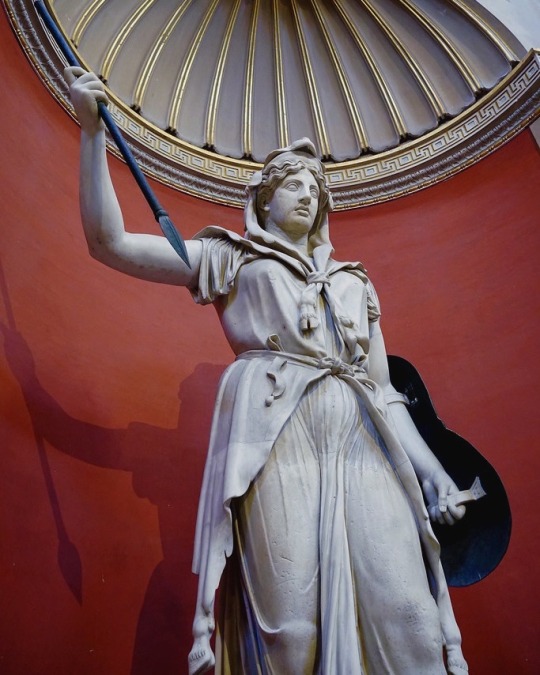
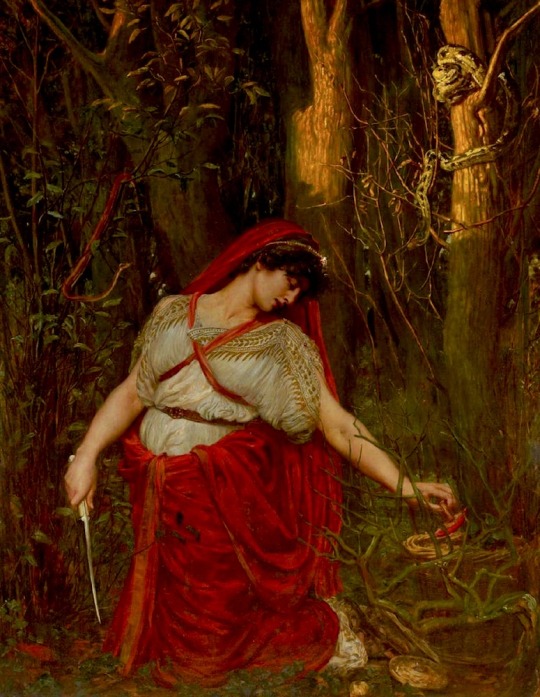
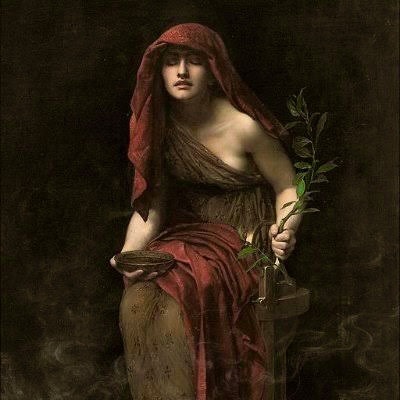
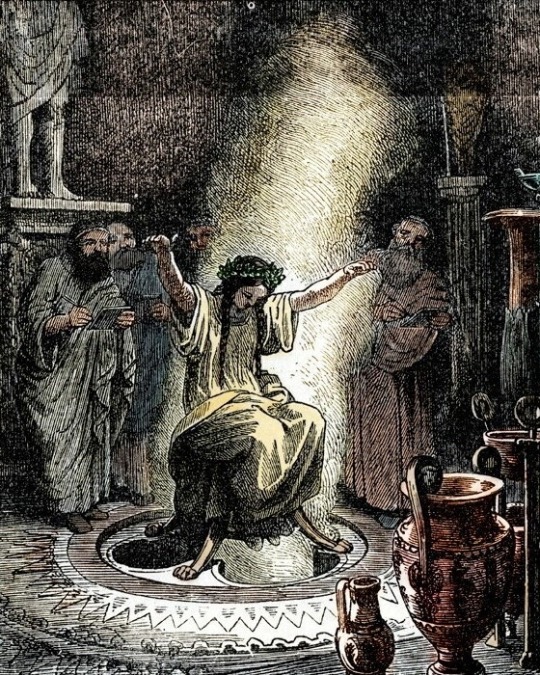
“I wish you a good night, with a Venetian benediction, ‘Benedetto te, e la terra che ti fara!’ — ‘May you be blessed, and the earth which you will make!’ — is it not pretty? You would think it still prettier if you had heard it, as I did two hours ago, from the lips of a Venetian girl, with large black eyes, a face like Faustina’s, and the figure of a Juno — tall and energetic as a Pythoness, with eyes flashing, and her dark hair streaming in the moonlight — one of those women who may be made any thing. I am sure if I put a poniard into the hand of this one, she would plunge it where I told her, — and into me, if I offended her. I like this kind of animal, and am sure that I should have preferred Medea to any woman that ever breathed.”
The mythical and historical allusions:
In Roman myth, Juno was Queen of the Gods as well as a military figure often depicted armed. In Greek myth, Medea was a sorceress who gets revenge against her unfaithful husband through murdering their children and his lover. Although “Pythoness” could refer to demonic witches in other uses, Byron is using it here as another name for Pythia or the Oracle of Delphi, a divine priestess and the most powerful female office in the ancient world.
Faustina is either a reference to the Younger or the Elder. Faustina the Younger was the wife of Marcus Aurelius; he revered her so much that he gave her enormous power, although later historians (probably falsely) accused her of being a murderer and adulteress. Faustina the Elder was the adoptive mother of Marcus Aurelius and was one of the most beloved Roman women in history, whose coinage often features Juno.
Byron's life and writing in context:
When he was living abroad in self-exile, Byron often sought to entertain his friends back home by sharing his adventures in lurid detail. His vivid letters became well-read throughout the 1800s, and are considered some of his best writing. Travel writing and adventure stories were extremely popular in the 19th century, and even most of Byron’s fiction champions these themes. Living abroad and traveling became marketable parts of Byron's celebrity. He blended his own experiences into his work, and chief among these were his romantic experiences.
Shelley once compared Byron to the Greek myth of Circe when writing in a letter about Byron's excessive amount of pets. Circe was known for seducing men and turning them into animals who roamed around her palace. Like a witch or an alchemist, Byron frequently transformed his lovers into characters through his writing. Like countless others, Margarita Cogni was mythically immortalized through the writer's description of her. She and Byron's other Venetian lovers have become part of the wider Romantic era mythology tradition, like the constantly retold tales of Mary Shelley's invention of Frankenstein, Percy Shelley's drowning, and John Keats' love for Fanny Brawne.
By using references to classical women in this letter Byron is not only paying tribute to mythology, history, and the Italian landscape in a way that his foreign audience would find tantalizing, but he is also exploring romanticized notions of classical female beauty which are at turns conventional and unconventional. He channels the gothic sublime through the otherworldly power and danger these women all represent, as well as channeling more traditional concepts of feminine strength rooted in modesty, beauty, and passivity. Byron creates poetic contradictions.
Just as he famously describes himself as “changeable, being everything by turns and nothing long,” he utilizes paradox and inconstance in his writing, such as in this satirical formulation of Margarita Cogni as the ideal lover who is both Goddess and woman, mistress and slave, contemporary and classical, masculine and feminine, wife and adulteress, murderess and murdered.
One can clearly see how this is the same chameolonic, binary-blurring poet who would go on to write the gender-bending themes of Don Juan — “If people contradict themselves, can I / Help contradicting them, and every body, / Even my veracious self?” — and who years beforehand had written She Walks in Beauty — where “all that’s best of dark and bright / Meet in her aspect and her eyes.”
#literature#english literature#lord byron#romanticism#poetry#dark academia#aesthetic#history#mythology#analysis#my analysis#my writing#my essays#byron#poems#letters#women#art#myth#greek#roman#british#english#academia#the romantics#love#romance
63 notes
·
View notes
Text
Mistakes in Magnificent century part II
Relationships
1. Suleiman and Hurrem

In the show, they talked about their love a lot, but what they failed about was showing it. It seemed like Hurrem was hopelessly in love with a man of a giant ego, who would bed and even fall for every second woman. Well, that's a huge lie, Suleiman was strictly monogamous to Hurrem, only two concubines were recorded to be sent to him they were gifted by the provincial governor,but they were set to marry by government officials after hurrem threw a tantrum. No more concubines were ever sent to him and Suleiman remained loyal to her ever since. Above that, the abusive relationship depicted in the show is pure drama, Suleiman never banished Hürrem, never asked her to kill herself to test loyalty etc. Their relationship was sensual and mutually convenient as we can see in their letters. However, my personal opinion is that Hurrem's love is a little bit exaggerated in the show, She was ready to kill herself and her children if Suleiman had died. However, I have never had the impression that Hurrem actually loved Suleiman that much, she definitely loved him,but even if the feeling was so big that it exceeded her own life, the love of her children was without a doubt greater, so in my opinion, if Suleiman truly fell ill in near death state, Hürrem's first instinct would have been to secure well being of her children.
2.Ayşe Hafsa Sultan and her in-laws.
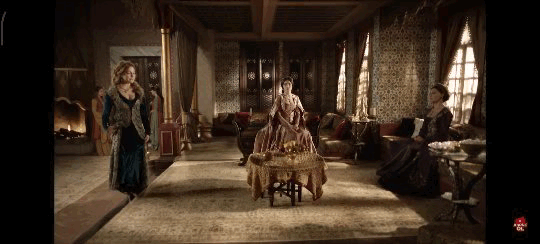
In MC, Hafsa clearly prefers Mahidevran over Hürrem,however in real life she understood her own and concubines position did not take sides in their hidden rivalry, as the manager of harem customs demanded that she would treat them according to their ranks, however can be deduced that Hafsa could not help,but have warm feelings towards Hürrem. We don't know the reasons, perhaps she liked her personality, enjoyed her company, respected her as the mother of 6 grandchildren or just loved her because she and her son loved each other so much. But one thing is clear, she was tolerating Hürrem more than any mother in law ever would, especially in her position. Their "special" relationship can be indicated by events of 1526. The provincial governor sent two concubines, one for Hafsa and one for Suleiman, Hafsa did an absolutely natural thing to prepare concubine for Suleiman and even gift her own one to him, that caused Hürrem to throw a tantrum and Hafsa, seeing Hürrem in that state, felt sorry for what she had done, sent concubines back and set them to marry other governors. That particular event gives us two assumptions: 1. Hafsa loved Hürrem enough to feel sorry for doing nothing wrong,just fulfilling her duties. 2. Hurrem's jealousy was not something new for them and she had likely done that before.
3.Hurrem and Mahidevran

First thing I would like to underline is that Mahidevran was never the only woman in Suleiman's life nor was she Haseki Sultan, so at first she would feel no threat from young Hürrem, However, things have changed after 1521, all other children of Suleiman died, Mahidevran became the mother of oldest prince and Hürrem was called to Suleiman again, that could have been humiliating for Mahidevran, because traditions were broken for a woman of inferior rank and now she was clear threat as not juts mother of other prince,but favourite of padişah. All those could cause tense between two women,but never in the history of them Living under the same room have Mahidevran beaten her, kalfas and aghas of harem would not let this occur and even if it did, punishment would have been recorded, so the story told by Venetian ambassador Andrea Navagero is either straight up dramatic lie or juts an exaggeration of tiny conflict that could have occured between two women. Otherwise, they were quite polite to one another and never showed hostility,when they met each other.
4. Relationship between sisters-in-law.
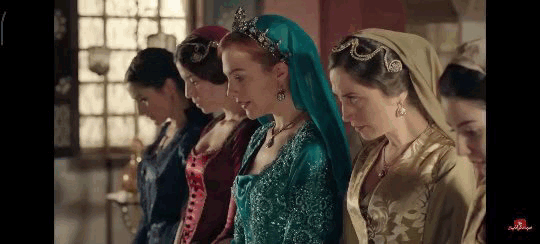
Most of Suleiman's sisters were portrayed against Hürrem for dramatic purposes,which to some extent was interesting but eventually grew boring.
It seems that out of all sisters Hatice was closest to Mahidevran, Şah was closest to Hürrem, beyhan had a very neutral attitude and probably respected both as their ranks demanded, while Fatma had no known interaction with Mahi- devran,but her relationship with Hürrem was stained.
As I have already said, Hatice had a close relationship with Mahidevran and regularly exchanged letters. In one of her letters mahidevran asks Hatice's well being and sends gratitude for the sincere kindness, friendship and compassion she and her husband showed to Mustafa and herself. Which means Hatice could have been either low key supportive to Mustafa or she was just a kind aunt to him. However, no tension between her and Hürrem was recorded, some even say she was great friends with her,but there is no proof for it. Either way, the fact that Hatice's and Hürrem's relationship was rather calm, we can assume that the support Mahidevran thanked her for was not her taking sides,but just expressing compassion towards the eldest nephew.
Second sisters Fatma, had no recorded interaction with Mahidevran,However she indeed had hostility towards Hürrem and Mihrimah, caused by their involvement in execution of her husband Kara Ahmed Paşa( who according to rumors became grand Vizier by Fatma's influence, but while possible, it's not proven). She was finally banished for her intrigues.
Beyhan did not have much of a relationship with either of them, she married quite early so did not spend much time in Manisa, where she could meet Mahidevran and due to the execution of her husband early in Süleiman's reign, she spent most of her life in voluntary exile.
Şah was really close to Hürrem,it is not known if the reason for the good bond was their mutual interest in charity and architecture or they shared some other political views. What is her close relationship with Hürrem, Süleyman and Mihrimah.
5. Gülfem and Hürrem

Before I go to specifically Hürrem and Gulfem, I would like to make a short summary of what the relationship between Gulfem and Suleiman was.
Gülfem was not Süleiman's concubine,but a high ranking harem manager,either promoted cariye or childhood friend of one of Süleiman's sisters. Indication of their close, platonic relationship is the fact that Suleiman entrusted Hürrem to her and she did not have a problem with it, which she would have if Gülfem was indeed a previous concubine. The relationship between her and Padişah was so close that she wrote openly and unofficially in her letters to him.
As for Hürrem, she was supervisor and mentor turned into closest friend Hürrem or perhaps any other Sultan had. In early days in harem, Gülfem was a double agent,who not only instructed Hürrem,but was also responsible for telling Suleiman about Hürrem's doing, in one such letters, Gülfem says that Hürrem had spent all the money,but when she sent agha to learn what the problem was Hürrem rejected him, latter she herself asked her about the problem and she surrendered, perhaps she had some fear and respect towards her. In later years, Gülfem constantly complains how tired she is to be a double agent and asks Suleiman to release her from such an obligation, which could indicate that Gulfem got closer to Hürrem . After that Gulfem indeed stopped telling Suleiman about her doings, so Hürrem either did nothing wrong anymore or Gulfem persuaded Suleiman to release her. The friendship of two women grew so much that Hürrem even mentioned in her greetings along with herself and her children.
6. Hatice and Ibrahim.
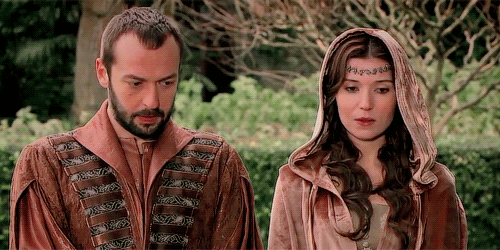
Long story short, they were never married, however it was theorised they were,when the Magnificent century was shot. Hatice was married twice first to Kapudan Iskender Pasha, then Çoban Mehmed paşa. İbrahim was married to a noblewoman for political purposes as an answer to raised aggression of people and high ranking officials after his assignation as grand Vizier.
7. İbrahim and Mustafa

In the tv show, Ibrahim's relationship with Mustafa is something like father and son's. However, in real life their relationship was far less heart warming. Mustafa was jealous of Ibrahim's closeness to Suleiman and once he expresses it openly, when Suleiman gifted İbrahim a luxurious saddle, who has to give it to Mustafa. Although, there are records of their units against common enemies, there is no indication of love between those two.
8. Handan and Safiye

Remember how the show depicted long lasting hatred between those two, that was always ending in Safiye dominating Handan even when she was Valide(particularly, in this scene)
In real life however, they tolerated one another and even created an alliance against Halime. Safiye definitely thought Handan to be easygoing. That's why she chose to support her son, thus remaining in power even after his accession, at least so she thought, however that "easygoing one" showed her true colours and banished that hell of a mother-in-law for good.
9. Kösem and "her children".

The exact number of Kösem's children is disputable, what we know for sure is that she was the mother of Murad, Ibrahim,Ayşe, Fatma and Kasım. The sources naming her children vary in numbers from 6 to 11. Other than those named, Hanzade sultan was almost certainly her daughter, historians also side to her, when it comes to identifying the mother of Şehzade Mehmed,who despite mixed opinions was almost certainly hers. However, sources list the birth of Mehmed, Gevherhan, Fatma, Ayşe and Hanzade to be between 1605-1608 and no birth of twins is recorded, so either one of them was born on different year and Kösem gave birth five times in a row or some of the children listed here were not hers. Gevherhan,in one of the letters, is named as full sister of Ahmed's eldest son, so in that case she was daughter of Mahfiruz. However, as there were no concubines listed as "mother of XX sultan or XY prince", so those children were either Kösem's or Mahfiruze's.
Osman, Bayazid and Burnaz Atike were not her children and despite her attempts to get close to Osman, Ahmed made it impossible, so the whole adopting young prince is just a dramatic exaggeration. Burnaz Atike was very close to Turhan Hatice, who was raised in her court and she likely supported her in rebelion.
10. Nurbanu and her in-laws.

In a TV show, the relationship between Nurbanu and her dear in-laws is more than a little bit intense.
However, in real life her relationship with Hürrem was more than just peaceful, based on the fact that Hürrem named the girl herself(Afife Nurbanu that means "victorious Queen of light") and she could have been Mehmed's concubine first and after his death and Selim's appointment as governor of Manisa she was gifted to him, we can assume that Hürrem chose Nurbanu as pillar of her princes and heir of her legacy. Considering, Nurbanu received letters from capital and was at least sometimes informed about the major events , she never fell from her favour.
In the show, Nurbanu has a very conflicting relationship with Mihrimah, however, there is not single recorded instance of Mihrimah having any conflict with Nurbanu, she even helped her sister in law to negotiate with France. Two women effectively shared the position of de facto Valide and Selim's advisors between 1566 to 1574. While Mihrimah was leading the old palace harem and fulfilling duties of regular Valide sultan, Nurbanu was arranging Topkapi affairs and party of supporters, something that was established during Hurrem's tenure.
Everyone was acknowledging Mihrimah's influence and ambassadors were trying to win her favour, while Nurbanu was working on peace treaty between Venice and Ottoman empire, she also started constructing Atik Valide mosque,while she was still Haseki and was at times reffered as "Atik Valide","Valide of shehzade" or "Future Valide", so her power was also established, not only that Nurbanu outranked Mihrimah and was closer to political affairs.
Rivalry between two women could be some misunderstanding. It was Mihrimah's daughter Ayse humashah, who might have had some dislike towards Nurbanu. She was one who raised Safiye and gifted it to Murad, so Nurbanu's disapproval of her, could threaten her future power. Or it could have been nothing personal,but Humashah's bond with Safiye, if they were friends, she would support her even against Valide sultan. However, if there was some conflict between those two is unknown. If there was any kind of conflict between two women Mihrimah would oppose or at least discourage such demonstration of power.
Nurbanu's relationship with her daughter-in-law is discussed here:
Bonus fact:

Those three musketeers of Manisa, were not actually three musketeers of Manisa.
Gazanfer was present there,but he was loyal to Selim and later served as chief Eunuch of Safiye Sultan, so his connection to Nurbanu was nothing significant.
Çanfeda on the other hand, was a close friend and second in command of Nurbanu,but not in Manisa, Çanfeda remained in the old palace during Selim's tenure as governor, she was summoned to be first harem stewardess of Topkapi palace, so their renowned friendship started during their youth, when they were newly enslaved.
#history#16th century#historical drama#magnificent century#magnificent century kosem#mc: kosem#medieval women#hurrem sultan#nurbanu sultan#ottoman empire#women in politics#sultanate of women#women in history#historical events#historical figures#ottoman sultanas#ottoman history#ottomanladies#ottoman#haseki hurrem sultan#kösem sultan#magnificent century kösem#muhteşem yüzyıl#muhtesem yuzil kosem
104 notes
·
View notes
Text
The Writer's (and anyone's, really) Guide to Venetian Masquerade Masks
Hello everyone! Welcome to this post. The newest fic I'm working on happens to involve masquerade masks, and I had to do a lot of research on them. Let me tell you. It took me a LONG TIME to find an adequate mask to make my characters wear, and I truly don't want people to have to go through those few hours of research for one sentence.
TL;DR: Choose colombina.
MASQUERADE BALL
A masquerade ball is, according to Wikipedia, is “a special kind of formal ball which many participants attend in costume wearing masks.”
It usually has a lot of singing and dancing
Were a feature of the Carnival season in the 15th century

Basically this
________________________
You’ve probably recognized this, haven’t you? Yeah, it’s those parties. We’re going to get into the Venetian ones because they’re cool + I gotta discuss masks, because they’re the reason I made this blog post.
There are 2 types of masks we’ll be covering: the traditional ones and the theater ones. I won’t be talking about the more contemporary ones.
________________________
MASKS
There are lots of masks you can work with, and honestly it’s kind of tough to choose what your characters should wear. Their main purpose is to hide the wearer’s face, and funnily enough no one knows when the Venetians started wearing them.
People wore them to gamble, engage in sexual acts, basically do everything you want to do, no strings attached. They were also worn by nobles to be viewed as equal, too, so it’s not just for illegal stuff.
The lists online were pretty useless–it was difficult to find any pictures/relevant information on the masks individually, so I’ve compiled a bullet-pointed list of some common types. A lot of it is taken from “The Complete Guide to Venetian Carnival Masks” from thecreativeadventurer.com.
BAUTA
Oldest style, originated in Venice
Often accompanied by tricorn hat and cape
Mask was generally white
Covered entire face but it was easy to eat, drink and speak without removing the mask
You couldn’t see the face though
Means “to protect”
Made of plaster, leather, or papier-maché
Worn by upper class during year, masses during the Venetian Carnival
Gender roles
Required to wear for women if they attended the theater
Men wore them during government votes to protect personal opinion

PLAGUE DOCTOR
Originally worn by doctors during Black Death
NOT FOR AESTHETIC PURPOSES
Curved leather long beak was filled with theriac: viper flesh powder, cinnamon, myrrh, and honey (amongst other things)
White, with two black round spectacles around eyes
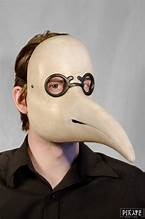
GATTO
cats
Made of papier maché
Historically worn by drag queens
Women also wore it too though

JESTER
Opposite of king–touched by madness
Uniform + masks consisted of a cap and bells
Acrobatics, jugglers, comedians, and sometimes magicians
Originally made of leather
JINGLE BELLS
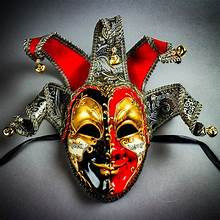
DAMA
Biggest. Heaviest. Full faced
Mainly women worn
Couldn’t find much on them
a pretty difficult option to choose since you can't do anything in them

VOLTO
Worn by common people during holidays
Simple, usually plain white with black around eyes
Can’t be worn while eating or drinking, couldn’t talk freely
originally called "larve", and were made of oilcloth

_____________
Now, onto the second mask category: commedia dell’arte, aka designs inspired by theater productions.
COLOMBINA
Half mask, generally worn by women
A great choice for characters because you can still eat, talk, and drink but can’t see eyes
Very pretty, the most well known version
Made of papier maché
Tied to the face by a ribbon or held up by long stick

PIERROT
We have a family friend called Pierrot lol
“Sad clown”
Worn by ceremony master
Can speak, drink through a straw because it has nose and mouth openings
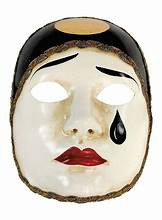
#fanfiction#writing tip#writer#writing#on writing#mask#venetian masks#historical#fanfic#masquerade ball#masquerade mask#fic#historical fashion
31 notes
·
View notes
Text








"The ritual of the choice of the first Tsarina unfolded according to the ancient tradition, and was organized by Ivan's grandmother, Anna Glinski. More than five hundred candidates arrived from all regions of Russia. A new church was built. Not accommodating all this troop of young ladies, the terem was enlarged, and new bathrooms with large Venetian glass windows were provided. In the baths of the Kremlin, the candidates performed completely naked. Ivan enjoyed the spectacle next to his grandmother. Among the young beauties was Anastasia Romanova. (Michael, one of her relatives, would later found the Romanov dynasty). With large green eyes, slightly pulled, perfectly oval tanned face, a Diana body, Anastasia fascinated Ivan. The marriage was of an unprecedented luxury.
[...]
Ivan loved his wife ardently. The sweet and virtuous Anastasia made him more human, more comprehensive. He often found himself in his wife's chambers with father Sylvester, pope of the Kremlin Cathedral, who taught and told the gospel to the Tsarina. It did not take long for the sovereign to make him his close adviser. He also had as friend a Kremlin nobleman, Adachev. The two advisers chatted frequently with the young Tsar, inspiring in him measures of clemency and bold reforms. Then began the brightest period of Ivan IV's reign."
The Tsarinas - The Women who Made Russia | Vladimir Fedorovski
(Loose translation)
#ivan iv#ivan the terrible#tsarina anastasia#ivan and anastasia#the terrible 2020#movie gif#facts#the ruriks
56 notes
·
View notes
Text
"Venice, caught in the middle of its daily routine, is constantly busy with something. Perhaps this is caused by the presence of water, which imposes mobility: here it is impossible to stop, one must head one way or another. Also in the narrow streets there is no room for staring, for standing out. Elderly women carry bags of provisions, as they do everywhere, men covered with plaster carry buckets of cement, someone unloads packages from a barge, two girls hurry somewhere in the streak of morning light that broke in through the narrow passage between corner houses. Even the tourists encountered in this Venice of the afternoons seem busy: here you can see that sightseeing is a serious activity that consumes masses of time, practically a whole day's work, physically exhausting and morally stupefying. Only in Piazza San Marco can you meet tourists who are truly happy: they do not demand anything from each other, they move like algae in the sluggish current of the crowd. They stare - but not too much - feed the pigeons, laugh. Because there is such a mass of them, lost among them are the silhouettes of Venetians who cut through the square in a hurry, the only land connection between the Castello and San Marco districts."
— Ewa Bieńkowska, Co mówią kamienie Wenecji (translation mine)
15 notes
·
View notes
Text
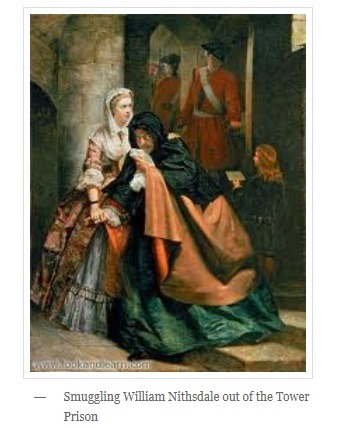
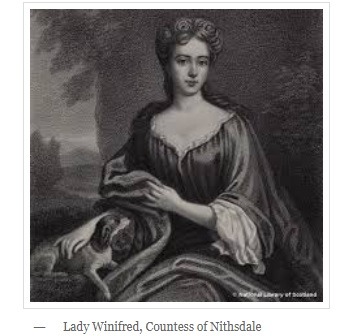
23rd February 1716 saw Lady Winifred Maxwell, Countess of Nithsdale, help her husband William escape from the Tower of London.
This is a great tale of a brave woman putting her own life on the line to help her husband escape.
Winifred Herbert was the daughter of William Herbert, 1st Marquess of Powis. Her parents accompanied James VII into exile in 1688 and her mother became governess of the young James Francis Edward Stuart, later to be known as the "Old Pretender". Winifred herself became a lady-in-waiting at the Jacobite Royal Court. On 2 March 1699, at the age of 27, she married William Maxwell, 5th Earl of Nithsdale, a member of a Scottish Catholic family.
The family returned home to Scotland in 1699 an settled back into life at their home at Terregles Castle near Dumfries. Maxwell worked hard to dispel suspicions of him in Scotland because of his Catholicism and his links with the Jacobites. However, he did come out in support of the Jacobites in the 1715 Uprising, and joined with the Northumbrian Jacobites under General Thomas Forster at Hexham. He was captured with other Jacobites at Preston and sent to the Tower of London. He was subsequently found guilt of treason the sentence was death and was to be carried out on February 24th 1716.
Winifred travelled to London to ask George I for clemency, but none was forthcoming. On the night of 23 February, the eve of the date set for her husband's execution, Winifred her maid, and two friends visited William at the Tower of London. Winifred distributed a generous amount of drinking money to the guards, and the women proceeded to come and go from William's cell, mingling with the wives of the guards and generally raising confusion about who was in the cell and who was not. Meanwhile, Winifred shaved William's beard and dressed him in spare women's clothing brought in for the purpose, including what has since become known as the "Nithsdale Cloak". William was then led from the Tower disguised as a woman by Winifred's maid, Evans, while Winifred herself covered the escape by carrying on a loud conversation with her - now departed - husband in an otherwise empty cell, before making good her own escape.
Winifred and William hid in London until he could be smuggled to France disguised as a servant of the Venetian Ambassador. Winifred herself then rode to Traquair House in Scotland to retrieve a number of family papers and arrange for their property to be cared for. She then, despite a huge search for her and her husband, returned to London, and traveled to the Continent. She eventually rejoined her husband at the exiled court of James Francis Edward Stuart in Rome. Winifred later became governess to Henry Benedict Stuart, the younger brother of Bonnie Prince Charlie
17 notes
·
View notes
Note
Is it true Anne Boleyn was described as pretty and beautiful by people at the time, but for some reason the idea she was kind of average won out, for some reason? Thanks.
HTF has sort of made this argument, although the truth is her appearance was spoken of variously, but not often in unequivocally negative terms by contemporaries (at worst we have Chapuys' 'thin and old', but this was a mere two years after describing her as of 'a state of health and of an age to have many more children', so...pinch of salt?), even the descriptive quote usually used of 'comparative beauty' to her with Elizabeth Blount is not entirely clear (the usual description of the quote is 'even her chaplain' said Anne was the lesser beauty, but going back to the primary source that doesn't seem to be the case:
Asked him if he knew these two ladies, and whether they were beautiful, worth leaving his wife for. He said he knew them both, and the mother of his son was eloquent, gracious, and beautiful, but the other lady was more beautiful still.
"Once Henry had decided to divorce Katherine of Aragon, fuller descriptions would follow. The first was in February 1528, when Lodovico Ceserari, the Duke of Milan's agent in Paris, assured the Venetian Signoria that she was 'very beautiful' (bellissima). The French diplomat Lancelot de Carle, who first saw her after his arrival in England in May 1535, agree[d] [she was] [...] 'beautiful and had an elegant figure'."
Hunting the Falcon: Henry VIII, Anne Boleyn & the Marriage That Shook Europe, John Guy & Julia Fox
The Sanuto quote that is usually trotted out also seems to be a case of mistranslation and not properly assessed, although his remark was that she was 'not one of the most beautiful women in the world', given that he was politically and religiously opposed, his remark is interesting in that he combines an account of her physical appearance with a judgement about her power, and compares it to her predecessor:
"[...]her eyes, which are black and beautiful and exert a greater effect on servants than the Queen's when she was in her prime.'"
Hunting the Falcon: Henry VIII, Anne Boleyn & the Marriage That Shook Europe, John Guy & Julia Fox
#anne boleyn#anon#it 'won out' bcus of sanders and because contemporary reports are mixed? i suppose#weir and borman definitely popularized it#they have misquoted that account as chapuys calling her 'that thin old woman'#sometimes they even credit it to a 'french ambassador' who does not seem to exist
13 notes
·
View notes
Note
okay I just saw a Richard III stan on twitter claim that there's no way Elizabeth of York could have loved Henry VII because he was Ugly(tm) and so I just had to say/vent: the obsession with using physical attractiveness to unironically rate and compare historical figures is really fucking weird. This generally tends to happen with women (Henry VIII's wives in particular) but it's pretty common to see it with fans of Richard III as well, who are generally negative to Henry VII. Which is both very frustrating and very funny, because putting aside the generic compliments issued to royals, NEITHER of them were hailed as singularly attractive or singularly charismatic during their time as far as I know, they both looked like Some Guys who ruled the nation and (in Henry's case, idk much about Richard's reign) were quite good at it. And in Henry's case, its doubly weird and mean-spirited because I believe he was sick when his portrait was being made?
I mean, it's certainly not as though someone insulting a historical monarch's physical appearance is a major crime or anything lol, you do you, but it does become an issue when it spills into an analysis and examination of them as rulers and individuals. There's really no need to turn important periods of history into a hotness contest.
Also (more of a general rant), generally speaking, attractiveness was a feature conveniently assigned to most people of high status, and was almost a exaggerated. It's also relatively easy to identity genuine undeniable attractiveness based on the sheer intensity and awe with which contempraries raved about the people who possessed it (Elizabeth Woodville, Edward IV and all their children were key examples of that lmao, as well as geoffrey of anjou and Philip iv of France as far as men were concerned), which was usually quite rare because the majority of people were not supermodels and were not expected to be lmao.
(a bit irrelevant, but I feel like the guy who played Henry in the white princess was absolutely perfectly for a younger version of his portrait, I haven't watched the show but I absolutely loved his casting)
Oh, I think Jacob Collins-Levy does look like a young Henry VII indeed, even if a more 'polished' version of him. Certainly, I think the real Henry VII had a much stronger nose, which leads me to the main part of your comment: some people find big noses attractive, for example. People experience attraction in such different ways! Someone might be attracted to another person's voice or hands, to someone's attention to detail or alternatively to their carefree attitude, to someone's jokes or their way of speaking or caring for their family or someone's intellect and insight. Attraction is a vast and varied universe, and to me it seems quite childish to reduce it only to someone's facial features. We don't even know what his body looked like, for example; we only have Vergil's word that his height was 'above the average', and Bishop Fisher's word that Henry was 'tall and of a fine build'.
Even if you consider Henry Tudor to have been the ugliest man in the world (which I doubt, as he was described as 'remarkably attractive' in his later years still), it's quite possible there was something about him that charmed people around him, in the sense that he was able to inspire extraordinary loyalty throughout his life. Thomas More said Bishop Foxe would give up his own father's head in order to serve Henry VII; Thomas Lovell was reported to have only one painting in his multiple residences, precisely a portrait of Henry VII. Henry was able to inspire and retain the trust of 400 Englishmen for two years in exile. The same thing that was attractive to his followers might have been attractive to Elizabeth of York as well, surely? We don't know!
According to a Venetian ambassador, Henry was 'gracious and grave', and according to Commynes, he was 'very pleasant, an elegant character, and a fine ornament in the court of France'. Once, during a conversation with the Spanish ambassador, his speech was described as 'like precious jewels'. I find it doubtful that Henry VII was an all-around unlikable, unattractive figure. And that's simply going by the premise that he was extraordinarily ugly, though when compared to other European rulers at the time, it seems reasonable to call him 'just some guy', if not actually attractive (see Charles VIII, Maximilian I, Louis XII, Ferdinand of Aragon, and even Philip 'the Fair').
I linked portraits in this ask but I don't even believe they are much conducive to a good discussion on attractiveness at all. It's not uncommon to find that many figures who were described as handsome/attractive (eg: Philip the Fair) don't actually look handsome/attractive to a 21st-century audience. And that might be simply because portraits or painting techniques of the time weren't able to transcribe their real physical attractiveness to us or because their ideas of attractiveness were different from ours—to which I ask: what's even the point of using portraits to call a historical figure attractive or unattractive, then? It's perhaps more useful to go by awed reports of a certain historical figure's attractiveness, as you said, and even then, absence of evidence is not evidence of absence. The resident Spanish Ambassador in England, for example, never once mentioned Elizabeth of York's looks in fifteen years, even though her beauty was mentioned elsewhere by other people.
Those types of comments against Henry VII do sound mean-spirited, as you said, even if not especially heinous (he and his family are, after all, dead). It's a sterile argument and proves no point as to a historical figure's ability to inspire loyalty or love in someone else, and even less as to their ability to rule well. If anything else, quite frankly it's not an argument at all, it's just the expected pettiness of a bad loser lol It gets even weirder at their insistence that Richard's reconstruction is especially handsome (which has inspired even some... questionable poetry).
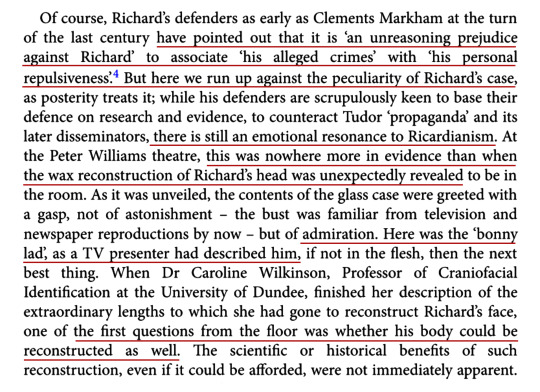
(x)
74 notes
·
View notes
Text
So, recently, @desmoonl brought up a woman on tiktok, claiming to be studying Ottoman history, who brought up that Mahidevran never actually beat Hürrem. Given the, at times, differing accounts on the matter, she asked how true that was.
The incident itself is first reported in a letter from Bernardo Navagero, a Venetian ambassador, in February 1553 (the contents of which you can find here). The date of such a dispatch is, really, the initial point of interest here. After all, the episode Navagero is describing would’ve occurred, at best, around the early 1520s (or at least before 1533) when Hürrem was still establishing her place within the harem. So why, if such a dramatic event occurred, was it not reported within that period? Why, instead, is it included in a letter sent out a full thirty years later?
This, to me, stands out even more when you consider that, had such an event occurred, it would have been actually a bit of a scandal as this was exactly the sort of thing not meant to be allowed within the walls of the harem.
“Mahidevran and Roxelana were together in the Old Palace for thirteen years. It is possible they got along during much of that time or at least maintained a cordial distance. They were probably rarely alone together, given the large number of women who lived alongside them. Hafsa, widowed princesses, high-ranking staff, retired concubine mothers including those of Selim’s several daughters—all were women of account in the harem who presumably had a stake in preventing ruptures. The strict decorum of the Old Palace was designed to head off incidents such as Navagero described. In a polity where the royal household was the government, disorder in the harem could provoke disorder in the state.”–Peirce, Leslie. Empress of the East: How a European Slave Girl Became Queen of the Ottoman Empire
While it could be arguably played for irony within the show itself, the constant reminders of how fighting is forbidden within the harem really isn’t a lie. And, given the countless figures that abounded, ready to enforce that policy, it’d be alarming for such an event to have occurred. Enough of a shock, truly, that it’d be even more of one for it to remain an untold tale for so long.
Admittedly, this is why Peirce theorizes that such a tale could have begun as another matter that had been thoroughly embellished by the time it reached Navagero. Unlike their counterparts in European courts, after all, these ambassadors were barred from entering a crucial part of the court. So it’s unsurprising that the rumors which made rounds got incorporated into their reports (take the accounts of Hürrem’s supposed witchcraft, for example).
The kernel of truth that Peirce works out of it, so to speak, is that, at the very least, the possibility of Mahidevran striving to defend her very real rank within the harem could be entirely probable.
“But can we trust Navagero’s story? It matters because Venice’s ambassadorial reports were read and valued in European capitals. They functioned as an index of intelligence as well as local public opinion that contributed, for better or worse, to Roxelana’s reputation. Tension between the two royal consorts was not unexpected, although the story of the brawl had perhaps been embroidered over time. Whether Mahidevran had an irascible personality or was prone to violence is hard to say; all other references to her in Venetian reports are exemplary. But the tale is not preposterous, and her self-defense to the sultan—the assault on her rank as senior concubine—is wholly plausible.”–Peirce, Leslie. Empress of the East: How a European Slave Girl Became Queen of the Ottoman Empire
So, could a disagreement of sorts have broken out between the two women? Maybe.
It had by then possibly become clear that Suleiman planned to break the rules when it came to Hürrem, which would have been an altogether unique threat to Mahidevran; one so unexpected it’d be difficult for her to know how to handle it.
That that disagreement could have then erupted into an all-out brawl? Unlikely.
I can somewhat understand why a person studying Ottoman history might want to set the record straight about this too as the misinformation surrounding it can be galling at times. I’ve had people earnestly insist to me that, not only did it in fact happen, but that it resulted in Mahidevran’s exile for a time from Topkapı Palace (which only proves the impossibility, really, as she and the harem didn’t reside there). There’s also been one rather notorious person that liked to use it to peddle further slander about Mahidevran, such as her attempts at poisoning being real rather than fictional.
12 notes
·
View notes
Text
Asteroids for the Womanizer vs. Knight in Shining Armor
Players, womanizers, casanovas, smooth talkers, hard-to-resist
Predators, predatory behaviors
Promiscuity, flirtatiousness, fulfilling sensual desires
Romantic or overly romantic; Idealistic or overly idealistic
Chivalrous, gallant, or wanting to be gallant towards others
Not succeeding in becoming a "knight in shining armor"/ideal person
Hanging onto a romantic past (personal past or in history)
Desperate for the attention of the other; doing anything for the other; simp
Where we want to be seen as a hero; where we want to be saved
Our ideal image of a good man; how we overidealize our perfect partner

7328, 3552, 29391
NOTE: All three asteroids are men or historically male. However, in astrology, I don't believe these have to be gender specific. So many ways these could play out in a chart. See what makes the most sense for you.
Casanova 7328
Named after Giacomo Casanova, a Venetian adventurer and writer
Known for his affairs with women, so much so that his name is synonymous with the term womanizer
Casual love and sex, nothing serious; flirtatiousness, games, short-term relationships
Dominated by sensual urges; passion for the opposite sex
Made sure not to get anyone pregnant
His modus operandi: Save an attractive woman from a bad lover; woman shows gratitude, and he seduces; affair begins; gets bored and tells her he is unworthy; pairs her with a worthy man and leaves
Using every persuasive skill that exists to soften the woman's heart
Values intelligent women but not educated women
Predatory, dangerous, especially for younger women/girls; doesn't go for too easy or too challenging targets
Known for gambling as well
I have Casanova in Capricorn in 5th house square Venus, conjunct Jupiter. This being in Cap in 5th conjunct Jupiter square Venus is giving me gambling vibes...or lots of short-term relationships? Both don't sound like me right now, but between the two, gambling seems more plausible. Had an intense lottery phase for a little while a few years back.
Don Quixote 3552
Named after Don Quixote, a Spanish novel by Miguel de Cervantes
Alonso Quijano (main character) reads too many chivalric romances and cannot separate fact from fiction
Under the name Don Quixote, he imagines that he is living out his knightly fantasies; feeds into his own delusions
Chivalry is dead; post-chivalric world sees chivalry as useless; hanging onto a romantic past
Don Quixote is in Leo 12th house opposite Mercury. Is it me, or does this placement sound like the character in the novel 😳 ? I wouldn't call myself delusional, but I do romanticize the past a lot, but all that romanticizing mainly stays in my fantasies (12th) in my head (Mercury). I just probably do too much romanticizing and should get back to reality every so often.
Knight 29391
Means a man who served a sovereign as a soldier in armor in the Middle Ages
Knight in shining armor = an idealized man who comes to the rescue of a woman in a difficult situation
Funny enough, I have Knight conjunct Don Quixote. It is also conjunct Pluto. I do idealize Scorpio men more than any other sign.

#astrology#asteroids#natal chart#birth chart#synastry#synastry chart#composite chart#casanova#don quixote#knight#knight in shining armor#womanizer#player#simp#chivalry#littledigest
150 notes
·
View notes